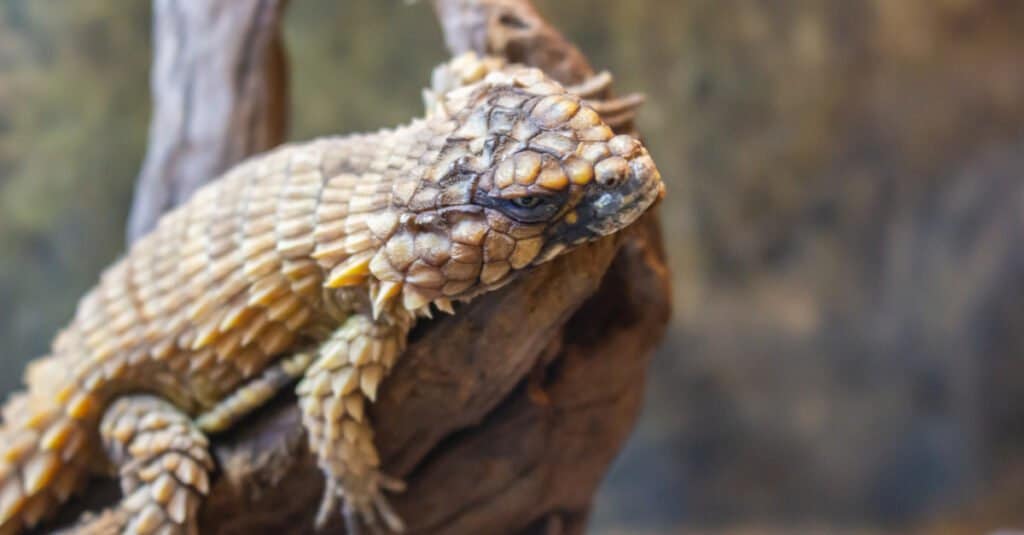Armadillo Lizard
.jumbotron {
background-image: url(“https://a-z-animals.com/media/2022/02/Armadillo-Lizard-header-400×300.jpg”);
}
}
@media only screen and (min-width: 641px) and (max-width: 920px) {
.jumbotron {
background-image: url(“https://a-z-animals.com/media/2022/02/Armadillo-Lizard-header-470×370.jpg”);
}
}
@media only screen and (min-width: 921px) {
.jumbotron {
background-image: url(“https://a-z-animals.com/media/2022/02/Armadillo-Lizard-header.jpg”);
}
}
Armadillo Lizard
Ouroborus cataphractus
They communicate through a series of tongue flicking, head bobbing and tail wagging, among other methods.
Armadillo Lizard Scientific Classification
- Kingdom
- Animalia
- Phylum
- Chordata
- Class
- Reptilia
- Order
- Squamata
- Family
- Cordylidae
- Genus
- Ouroborus
- Scientific Name
- Ouroborus cataphractus
Read our Complete Guide to Classification of Animals.
Armadillo Lizard Conservation Status
Armadillo Lizard Facts
- Prey
- Mainly desert insects
- Name Of Young
- Baby
- Group Behavior
-
- Group
- Fun Fact
- They communicate through a series of tongue flicking, head bobbing and tail wagging, among other methods.
- Estimated Population Size
- Unknown
- Biggest Threat
- Black market poaching
- Most Distinctive Feature
- Scaled, spiky shell
- Other Name(s)
- Armadillo girdled lizard, Golden-armadillo lizard, dragon armadillo lizard
- Gestation Period
- Two months
- Litter Size
- 1-2
- Habitat
- South African deserts
- Predators
- Birds of prey
- Diet
- Carnivore
- Favorite Food
- Desert insects, scorpions, plants
- Type
- Reptile
- Common Name
- Armadillo lizard
- Location
- Desert
- Group
- Squamata
This post may contain affiliate links to our partners like Chewy, Amazon, and others. Purchasing through these helps us further the A-Z Animals mission to educate about the world’s species..

Spiders that fly! Fish that walk! And 1000+ more incredible animals. Discover them all for FREE
.photo-gallery {
–margin: 0px auto 0px;
–padding: 0px 0px 0px 0px;
}
.gallery-link {
background-image: url(“https://a-z-animals.com/media/2022/02/Armadillo-Lizard-header-1024×535.jpg”);
background-repeat: no-repeat;
background-size: cover;
background-position: center;
height: 500px;
justify-content: center;
text-align: center;
align-items: center;
display: flex;
border: 2px solid #000;
}
.gallery-link img {
height: 50%;
}
@media only screen and (max-width: 768px) {
.gallery-link {
height: 300px !important;
}
}
View all of the Armadillo Lizard images!
If you’ve ever wanted to say you own a dragon, the armadillo lizard is the perfect pet for you.
Also called the armadillo girdled lizard, Golden-armadillo lizard, and dragon armadillo lizard, this South African reptile has spiny coats of armor, a cool defense mechanism that also leaves them — despite their tiny size — looking like something you might see stalking the skies of Game of Thrones.
The lizard is the ideal reptile pet. It’s extremely sociable. In the wild, these lizards’ adaptations include grouping in batches of four to six creatures. It’s strongly advised if you have one in the home, you let them live with others. Still, despite a potentially friendly nature, these creatures aren’t keen about handling.
In captivity, the armadillo lizard requires little maintenance. Many lizard lovers adore their pet armadillo lizards. But these animals are hard to get your hands on as the lizard cannot be exported from its native country.
The name comes from the armadillo. Armadillo is Spanish for “little armored one.” The name refers to the scaly, bony plates covering the mammals head, legs, back, and tail. But despite their scaly identifications, the mammal armadillo is not related to the armadillo lizard at all. But like the armadillo, when threatened, the armadillo lizard bites its tail and curls into a ball.
Read on for a comprehensive review of the armadillo lizard, how it’s unique beyond its appearance, and its potential as a pet. The pet lizard species will surprise you.
5 Armadillo Lizard Facts
Here are some interesting facts about the armadillo lizard.
- The animal has few land predators thanks to its hardened spines and armored exterior. But the lizards are prone to attack by birds of prey looking for food.
- Most reptiles lay eggs. The armadillo lizard gives live birth to its young, unlike their cousin reptile pet. The pet lizard species actually feed their baby. Another identification that differentiates them from other lizards.
- Rising temps and wildfires are a direct threat to these animals.
- While the rest of the world glamors to put them in enclosures, it’s illegal to keep these lizards as pets in South Africa or to export them.
- The tails grow longer than the rest of the armadillo lizard’s entire body.
Armadillo Lizard Scientific Name
Ouroborus cataphractus is endemic to South African deserts along the western coast.
The lizard got its common name from its defensive stance. Like the mammalian armadillo, the lizard curls into a ball to protect itself.
The dragon armadillo lizard is a diurnal animal with rows of tough spiny scales all over its body. The most vulnerable part of their body is the belly. The lizard protects it by biting its tail and balling up. This leaves only their hard exterior for predators. As much as they want the lizard as prey, most predators tend to not want to deal with the hard, scaly surface.
Armadillo Lizard Appearance & Behavior
Here are some facts about the armadillo lizard’s behavior, adaptations, and appearance.
Appearance
The armadillo girdled lizard’s most obvious identification is its armored skin. The spiny armor is osteoderms. That’s bony plates embedded in the dermal layer of the critter’s skin. Osteoderms are common with several reptilian species, including alligators, crocs, and some tortoises.
Tiny in size, the animal’s body is flat. The feature lets the lizard squeeze between small crevices. Colors tend to be dull, typically light to dark brown or yellow-brown. The underbelly is yellow with black patterns. Not only are the eyes black but so is the scaling around the mouth.
While you’ll find resources that say otherwise, the adult lizard only grows a little over four inches in size. Typically, males are a little longer in length than females. Another identification that separates the sexes is males have broader heads and hemipenal bulges.

flyingv3/Shutterstock.com
Behavior
These reptiles are slow because of their heavy build. That build makes hiding and passively defending itself from predators important as the armadillo girdled lizard can’t run.
The lizards like to spend their time hiding between rocks and taking in the sun. In the wild, they gather in groups of up to six. Some researchers say this behavior is for managing protection from predators. But while they avoid physical conflict, the lizard does have extremely powerful jaws. The armadillo lizard has bitten off toes.
The males are territorial about their habitat, especially during mating seasons. That begins in September and lasts eight weeks. The males are aggressive in pursuit of a mate.
While most reptiles lay eggs, females give birth to at least one baby. On rare occasions, they may have two offspring.
These creatures go foraging for their diet, traveling up to a length of 18 miles away from home to find food.
These creatures have a lifespan of 25 years in captivity. There is no research on how long of a lifespan they have in the wild.
The Armadillo Lizard as Pet
It’s illegal to export a wild-caught dragon armadillo lizard out of South Africa. But they are easily caught and made a pet. The pet lizard species make for easy prey to hunters as they’re slow and tame.
Unfortunately, some people badly want the pet. Due to this, the pet lizard species is considered vulnerable because of the abundant capture to feed demand. If you do want one as a pet, look for a reputable breeder in your area.
Armadillo Girdled Lizard Habitat
O. cataphractus likes hiding in crevices in rock outcrops and mountain slopes. They love habitats surrounded by dwarf perennial shrubs.
The reptiles diet mostly on termites, millipedes, beetles, and sometimes scorpions and plants.
For food, pet owners feed their lizards butterworms, superworms, and pinky mice.
Armadillo Lizard Predators & Threats
The biggest threat to the lizard is humans who capture them for the black market. Other threats include wildfire and climate change.
The animal’s conservation status is of “Least Concern.” But the South African government sees the creature in need of protection because of its black market value.
It is illegal to have these reptiles as a pet in their native country or to export the animals. The Cape Provincial Ordinance is set up to help sick and injured armadillo lizards.
What Eats the Armadillo Lizard?
Most predators on the South African desert grounds shy away from the armored reptile because of its shell. Prominent predators are birds of prey, such as eagles, falcons, and ospreys.
What Does the Armadillo Lizard Eat?
The lizard diets on a variety of insects for the most part. They also chow down on the occasional plant if necessary.
Reproduction, Babies and Lifespan
This lizard is polygynandrous. That means between the September to October mating seasons both sexes take multiple partners.
The females do not lay eggs. The gestation period is then between six and eight months. Eggs hatch in the mother and she births a baby and on occasion two. In some cases, females may stop mating for a year to care for the baby.
The baby armadillo lizard turns mature and productive after reaching a body length in the vicinity of 3.75 inches.
In captivity, it’s determined the animal has a lifespan of up to a quarter-century. There’s no record of lifespan for animals living in the wild.
Armadillo Girdled Lizard Population
The reptile certainly faces its share of threats, including capture, winged predators, rising temps, and wildfires. Still, there are no official studies scrutinizing the size of the population. But as its status is of “Least Concern” to environmentalists, it’s safe to say this lizard populace is in good condition.
View all 127 animals that start with A
Armadillo Lizard FAQs (Frequently Asked Questions)
Where Can I Buy an Armadillo Lizard?
Reach out to local reptile or general pet stores. If you can find a reputable one, buy a captive-bred from a private breeder for a pet. The pet species is rare as it won’t produce in great numbers.
What Do Armadillo Lizards Eat?
As slow-moving critters, these carnivores use sit-and-wait adaptations to catch crickets, spiders, termites, millipedes, and other insects in the wild.
How Much Is an Armadillo Lizard?
As they are hard bred, a dragon armadillo lizard will cost between $1,000 to $2,000.
Is an Armadillo Lizard a Good Pet?
The lizards make great pets for beginners. The scaly reptiles are very sociable and easy to take care of. Experts suggest because of their nature it’s best if you have at least two.
Are Armadillo Lizards Poisonous?
No, they are not. But they have a powerful bite that you’re not likely to forget anytime soon. Fortunately, the animal is more likely to go into its defense curl as opposed to reacting defensively.
Can You Handle an Armadillo Lizard?
Yes, but do it with care. As stated, the lizard is more likely to curl up.
Are Armadillo Lizards Endangered?
No. Currently, none of the conservationist organization sees the species as endangered.
What Colors Are the Lizards?
These lizards do not come in a range of colors. They’re basically browns, blacks, and yellows.
Sources
- Unique Pets Wiki, Available here: https://uniquepetswiki.com/armadillo-lizard-price/
- Wikipedia, Available here: https://en.wikipedia.org/wiki/Armadillo_girdled_lizard
- Everything Reptiles, Available here: https://www.everythingreptiles.com/armadillo-lizard/#What_Do_Armadillo_Lizards_Eat
- Facts, Available here: https://facts.net/armadillo-lizard-facts/
- SANBI, Available here: https://www.sanbi.org/animal-of-the-week/armadillo-girdled-lizard/#:~:text=Ouroborus%20cataphractus%2C%20previous%20name%3A%20Cordylus,spiny%20scales%20covering%20its%20body.
- Pets on Mom, Available here: https://animals.mom.com/threats-armadillo-lizard-2979.html
- Wikipedia, Available here: https://en.wikipedia.org/wiki/Armadillo_girdled_lizard
- Animalia, Available here: https://animalia.bio/armadillo-girdled-lizard
















